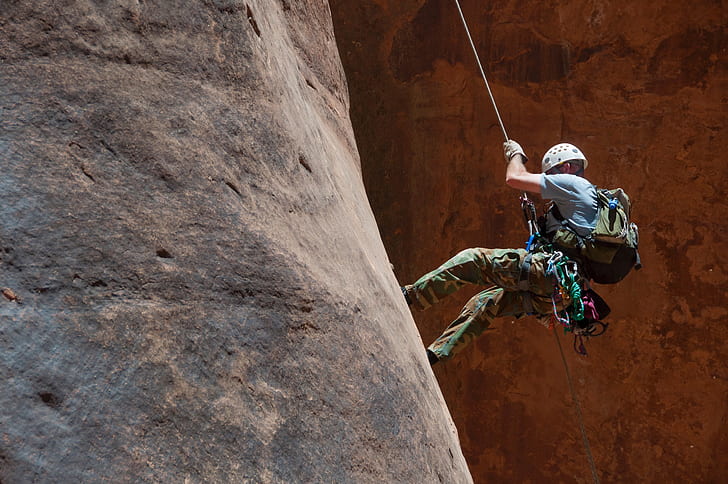Have you ever experienced the thrill of anticipation before plunging over the edge into a secretive, gloomy cave? An exciting adventure that combines thrill and a feeling of accomplishment is caving rappelling. It is not without difficulties, though. For many, the enjoyment can be overshadowed by a fear of heights or worries about safety. You’re not alone if you’ve ever been concerned about tripping or not being ready. Luckily, you can transform those fears into bold leaps into the unknown with the correct advice and a little practice.
Preparation is the key to a successful rappel. Knowing the fundamentals of rappelling makes a big difference, regardless of experience level. We’ll walk you through all the important advice in the sections that follow, from getting ready for your descent to making sure you’re safe to perfecting the technique. If you follow our instructions, you’ll soon be rappelling like a pro.
Now let’s get started with these suggestions to ensure that your caving rappelling experience is both safe and enjoyable!
Understanding Caving Rappelling
What is Caving Rappelling?
Caving rappelling is the practice of using a rope to descend into a cave or other natural formation. To ensure a safe descent, this technique calls for proficiency and repetition. You fasten yourself to a rope and descend gradually, frequently into difficult and shadowy areas.
Common Problems People Face
Many people experience anxiety about their safety when rappelling or a fear of heights. The technical aspects might be confusing to others. You’re not alone if you’re concerned about mishandling the rope or falling.
Quick Solutions
The best strategy to deal with these problems is to get the right instruction and practice. Always rappel with a partner or guide, and become familiar with the tools and procedures. Continue reading for more specific advice!
Step-by-Step Guide to Safe Rappelling
1. Gear Up Properly
Make sure you have the appropriate equipment before you even consider descending. A strong rope, gloves, a helmet, and a harness are required. Look for wear and tear on your equipment. You have to ensure your safety, so invest wisely in equipment.
2. Understand Your Rope
Rappelling ropes are designed to support your weight and withstand friction. Make sure your rope is in good condition. If you’re unsure, ask a professional for advice.
3. Get the Knot Right
Mastering knots is crucial. The figure-eight knot is commonly used for rappelling. Practice tying it until you can do it without thinking. A secure knot is your lifeline.
4. Harness and Rope Setup
Attach your harness to the rope using a carabiner. Make sure the rope is threaded correctly through the rappel device. Double-check everything before starting your descent.
5. Practice Your Descent
Find a practice area where you can safely practice rappelling. Start from a lower height and gradually increase as you gain confidence. Pay attention to your body position and the feel of the rope.
6. Descent Technique
When you’re ready to rappel, lean back slightly to keep your body perpendicular to the wall. Use your legs to control the descent, not just your hands. Keep your movements smooth and steady.
7. Communicate with Your Team
If you’re rappelling with others, communication is key. Establish clear signals and check in with each other before and during the descent.
Tips for Rappelling Faster and More Efficiently
Practice Regularly
The more you practice, the more confident and quicker you’ll become. Regular practice helps you become familiar with your gear and improve your technique.
Use the Right Equipment
Ensure your equipment is suited for the type of caving you’re doing. Lightweight gear can help you move faster, but it must still be reliable.
Stay Calm and Focused
Rushing can lead to mistakes. Stay calm, focus on your technique, and keep a steady pace. Confidence will help you rappel faster.
Ensuring Safety While Rappelling
Pre-Rappel Safety Checks
Before you start, double-check your harness, rope, and knots. Ensure everything is secure and functioning correctly.
Use a Backup System
For added safety, use a backup rappel system. This can be an extra rope or safety device that helps prevent falls.
Practice Emergency Procedures
Know what to do in case of an emergency. Practice rescue techniques and have a plan in place.
Read about the ascending rope technique.

You Might Like to Know
How to Prepare for Rappelling?
Preparation starts with choosing the right gear and practicing in a safe environment. Make sure you understand how to use your equipment and practice basic techniques.
Can You Fall While Rappelling?
Yes, you can fall if your equipment fails or if you’re not using the proper technique. That’s why double-checking gear and practicing safely is essential.
How to Rappel Faster?
To rappel faster, practice regularly and ensure you’re using the right equipment. Stay calm and use smooth, controlled movements.
How Can You Make Sure You Rappel Safely?
Ensure your gear is in good condition, double-check all setups, and use backup systems. Practice safety procedures and stay focused during your descent.
What Happens If You Let Go While Rappelling?
If you let go, you risk falling, which can be dangerous. That’s why it’s crucial to maintain a firm grip and use safety equipment properly.
What is the Physics Behind Rappelling?
Rappelling involves controlling your descent using friction and gravity. By managing the friction on the rope, you can control your speed and safely descend.
What is the Difference Between Lowering and Rappelling?
Lowering involves being hoisted down by another person or device, while rappelling is a self-controlled descent using a rope and rappel device.
How Do You Ascend Rappelling?
Ascending requires different techniques, like using ascenders or climbing gear. It’s more challenging than rappelling and requires additional skills and equipment.
How Thick is Rappelling Rope?
Rappelling ropes typically range from 9 to 11 millimeters in diameter. The thickness can affect the rope’s strength and handling.
Conclusion
Caving rappelling is a thrilling and rewarding experience, but it requires careful preparation and practice. By understanding your gear, mastering the technique, and prioritizing safety, you can enjoy this adventure with confidence. Remember, practice makes perfect, and staying calm under pressure is key. With these tips, you’ll be well on your way to becoming a skilled rafter, ready to take on new challenges and explore the hidden depths of our world.
Read about mastering the single rope technique.
